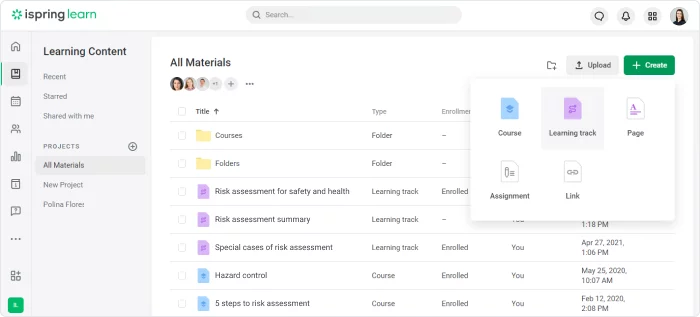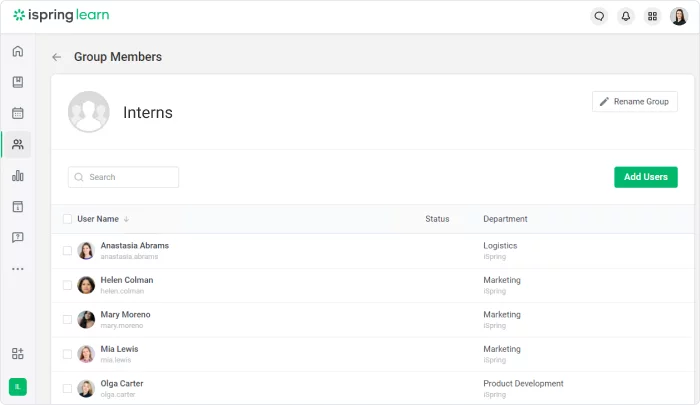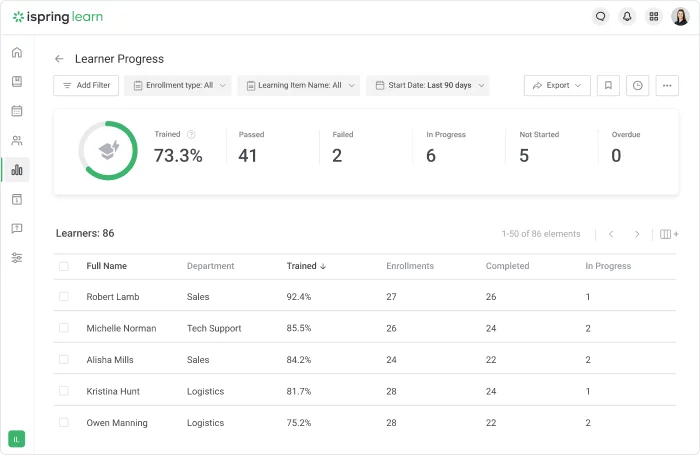What Is an LMS? Definition, Benefits, Types

What do educational institutions, billion-dollar enterprises, retail stores, and coffee shops have in common? They all use a learning management system (LMS) to organize and manage their training process.
Earlier LMSs used to be fairly simple: they stored course content in the form of text, videos, or presentations. However, learning platforms have evolved since then, and now they’re more than course storage. LMS software uses in-depth tools that allow you to analyze skill gaps, better understand student performance, and make your learning experience fully transparent.
In this article, we’ll discuss what an LMS is, what types of learning management systems exist on the market, and how a platform can benefit your business.
What Is an LMS?
An LMS, or learning management system, is software that helps you organize, implement, and manage online learning environments. It serves as a centralized library where students access interactive learning materials and assessments, while trainers monitor their progress and overall performance.
An LMS helps businesses streamline onboarding processes, improve training consistency, and achieve measurable ROI. The right learning management software can significantly optimize the learning cycle and ensure a cohesive approach to employee development and organizational growth.
Let’s break down each component of the acronym and the very concept of an LMS:
- L — Learning. This type of software is designed for convenient learning anytime, anywhere. Learners can access an in-house knowledge base, take assessments, and complete practical assignments.
- M — Management. Unlike file sharing services, a learning platform is not just a heap of files. It enables admins to manage user data and enrollments in courses, organize content into comprehensive training programs, and control how learners progress in the training they’re taking.
- S — System. It’s a computer system that processes various types of data and puts them all in order. It collects statistics, runs reports, and automates grading, streamlining the entire training process.
What Is an LMS Used For?
Learning management systems are versatile tools that can help you organize and manage various types of training programs. Here are the most common education software use cases:
- Onboarding. With a properly structured onboarding training program, you can deliver all the necessary information online, allowing new hires to study at a time that’s convenient for them. Plus, you can train remote workers, reduce time spent on training, and prepare employees for a smooth start to their new jobs.
- Employee training. An LMS lets you build courses, upload learning materials, manage assessments, evaluate learner progress, and measure overall employee performance.
- Compliance training. Learning management software automates compliance training and stores policies and regulations. So, employees can easily access materials and refresh their knowledge at any time.
- Sales training. Learning platforms can improve sales performance and customer satisfaction. Sales reps can stay abreast of product updates, participate in interactive role-plays, and monitor their progress.
- Customer training. With an LMS, you can onboard new customers, educate prospects, and show new product features to existing customers. The software also allows you to reduce costs because pre-made online customer training is cheaper than one-on-one demos.
Also read: How to Develop an Employee Training Program
Who Uses an LMS, and How Do They Do So?
The size and scope of organizations that leverage LMSs are pretty broad. They can be a large global enterprise with thousands of learners or a startup that uses an LMS for small businesses. And, of course, there can be nonprofit organizations, government agencies, and educational institutions.
Let’s take a look at how people can benefit from an LMS in their work:
- Corporate trainers use learning management software to onboard new employees, create personalized online courses, deliver compliance training, foster professional development and technical expertise, and monitor learners’ progress.
- Small business owners use LMS solutions to provide cost-effective and standardized employee training that’s available on desktop and mobile devices. The software helps entrepreneurs deliver consistent training materials and evaluate employee performance within a reduced budget.
- Teachers employ learning management solutions to create virtual classrooms, distribute course materials, post quizzes and assignments, and engage with students in a collaborative learning setting.
- Nonprofit program managers can use an LMS solution to provide training and educational resources to their staff and volunteers all over the globe.
- Government agency administrators deliver training and compliance programs to their employees and citizens via learning platforms, streamlining the administrative processes involved in managing a large workforce.
- Healthcare department managers use LMS platforms to train staff on the latest medical laws, best practices, and technologies.
What Are the Benefits of an LMS?
There are many obvious advantages to using an LMS, both for businesses and learners:
| For businesses | For learners |
| Reduce training costs | Access learning content anytime and anywhere |
| Reduce the time needed for employee onboarding | Study at your own pace |
| Stay on top of compliance training and keep everyone up to date with the latest regulations | Get customized training |
| Deliver quality product training at scale | Receive instant feedback |
| Improve work performance and create opportunities for promotion | Monitor your progress and identify areas for improvement |
| Ensure knowledge retention | Stay motivated and focused on your goals |
| Educate end users on product qualities or features with customer training | Collaborate on assignments and projects with other learners |
| Maintain a unified approach to marketing, sales, and customer service through channel partner training | Revisit and review courses and materials as needed |
Feel free to examine more cases and learn exactly how corporate LMSs can drive your business success.
Types of LMSs
Let’s move to a more technical aspect to see what types of learning platforms exist and how they differ.
Corporate vs. Academic

Both corporate and academic LMSs provide access to course materials online and automate different aspects of training processes, but they have some differences:
- Learning goals. Academic learning aims at producing excellent students who have a profound knowledge of subjects and strive to learn more. Here, theoretical knowledge as the basis for strong practical skills is the end goal. In turn, corporate training focuses on practical application, and one of its primary objectives is ROI.
- Course timeline. For workforce training, time limits are shorter, so a corporate training platform must be flexible to fit all time frames and business needs. Semesters, trimesters, and quarters — these are the time frames for educational institutions. Here, you need to schedule units such as holidays, exam times, and periods.
- Certifications vs. grades. Corporate LMSs typically allow you to track and complete certifications. Academic software tracks learner progress through its grading system. It provides grade books to track attendance, assignments, and other student information.
- Tools for social learning. An academic learning platform usually lets you create student groups for class projects and breakout sessions, use discussion boards, and hold web conferences with a built-in tool.
- Content updates. Educational LMSs don’t need to be updated regularly because the content is mostly based on the sciences and humanities. In contrast, a corporate LMS should be able to quickly and easily update courses to match changing market needs and legislative requirements.
iSpring Learn is an example of a corporate LMS, while Anthology (formerly BlackBoard) is an academic learning platform.
Free vs. Paid

When choosing between a free and a paid platform, you need to know that not all free LMSs are, in fact, free.
Most LMS platforms offer a freemium pricing model: you get the basic version for free, and you can buy extra features. ATutor is an example of an open-source LMS that uses the freemium model.
If we’re talking about open-source LMSs, there’s no license fee. However, you’ll need to invest in technical expertise and resources to set up, customize, and maintain the system.
The ideal solution for users without an IT background is commercial LMS software. It’s typically much easier to deploy and use, offers tech support services, and doesn’t incur additional costs. Again, iSpring Learn is an example of commercial learning management software.
SaaS/Cloud LMS vs. Locally hosted

You can either store all the data on your company’s servers, thus hosting the system yourself, or you can select a SaaS LMS platform and leave it to your vendor to deal with server load, backups, and security. A SaaS platform like iSpring Learn is the best match if you don’t have IT staff in place and want to focus on creating course content.
A locally hosted LMS is a learning management system that’s installed and runs on your servers, rather than being accessed online through a cloud service. In other words, you’re responsible for maintaining the hardware, software, and data security. Locally hosted LMSs offer more customization, data privacy, and integration with other local systems. However, you also need more IT resources and expertise to manage the LMS platform effectively.
Chamilo is a self-hosted learning management solution.
Some companies avoid cloud-based learning management systems because of data security concerns. They worry that their information stored on a remote server could be compromised. However, there are different ways to safeguard your data with cloud-based LMSs, too. For instance, ensure that the LMS vendor has effective encryption protocols and will back up your information.
LMS vs. LCMS (Learning Content Management System)

If you’re going to build courses in-house, you can choose between two alternatives: either buy an LCMS with course-creating functionalities (e.g., Auzmor Learn) or purchase an LMS and an eLearning authoring tool separately.
When choosing between the two, you should be aware of these potential hiccups:
- Built-in course editors usually have serious functional limitations.
- Not all LMSs and authoring tools are fully compatible.
If you want to avoid compatibility problems and create beautiful interactive courses, choose an LMS with a bundled authoring tool. One example is the iSpring Learn LMS that comes with iSpring Suite. This integration allows you to create professional-looking e-courses, easily upload them to the platform, and enjoy advanced reporting capabilities.
LMS Standards
In simple terms, an LMS standard is a universal language for communicating with learning software. Selecting a unified standard for both eLearning authoring tools and LMSs means that information will be successfully shared between them.
Here are the five major LMS standards that predetermine the compatibility between an LMS and an authoring tool:
- AICC. This is the oldest technical standard that allows you to transfer training content in HTTP format. It is no longer evolving, but there are LMSs and authoring tools that still support AICC.
- SCORM. Almost every learning platform recognizes this standard. It enables content to interact with the system, track learner progress, and manage the course structure. There are technically five versions of SCORM: SCORM 1.1, SCORM 1.2, SCORM 2004 2nd Edition, SCORM 2004 3rd Edition, and SCORM 2004 4th Edition.
- xAPI, or Tin Can. This is a next-generation version of SCORM that can exchange data with talent management systems or mobile apps. The standard lets you track most learning activities, including experiential learning and simulations.
- LMS LTI. This standard is especially popular in higher education because it enables content creators to build courses within their own tools and share them with learners on different platforms.
- cmi5. It’s the newest standard that provides all the capabilities of SCORM and xAPI together. Thus, cmi5 content can be viewed on mobile devices, even offline, and you can get detailed statistics in PDF, video, or game formats.
Also read: Choosing the Best SCORM-Compliant LMS
Now, let’s proceed to the next level of understanding an LMS and explore it in terms of common features.
LMS Features
There’s no universal agreement on the full feature set of a standard platform, but you can think of the first three items on the list below as basic LMS features and the rest as advanced ones.
- User management. You can add and edit users, assign user roles, and combine learners into groups and organizations.
- Course management. Learning management software allows tutors to upload and share training content with students, reorganize course modules, categorize courses, and create assessments based on course materials.
- Progress tracking. An LMS assesses learner performance in real time.
- Content creation. This can be a built-in editor that allows you to create page-like courses.
- ILT Classroom. The LMS can provide extended support for classroom-based initiatives (e.g., managing schedules and monitoring attendance).
- Mobile learning. Some LMSs have native mobile apps that allow offline course access.
- Social learning. It can serve as a social tool that allows you to unite students into groups for class projects, create discussion boards, and conduct webinars.
- White labeling and customization. Your platform might allow customization to help maintain brand consistency within the learning experience.
- Gamification. Points, awards, ratings, and badges can increase learners’ engagement, motivation to study, and retention.
- Certification. The LMS can issue certificates of completion for professional certification.
- Tracking learner progress. Learning management solutions create detailed LMS reports that include satisfaction and completion rates, assessment results, average scores, and other course stats.
- Artificial intelligence. AI-powered assistants personalize the learning experience and streamline course creation.
For more details about must-have and optional features, see this article about LMS requirements.
LMS Pricing
When looking for a learning management system, you can’t avoid the financial aspect. To choose the best option for your business, see what pricing models exist and how they work.
Different LMS vendors prefer different pricing schemes:
| Pay per active user | Pay per learner | Pay as you go | License Fee / Subscription |
| You pay for each person who actively uses the LMS during each billing cycle. On average, this costs $5 per user/month. | You’re charged for a fixed number of learners, regardless of whether they are active or not. Prices vary from $1 to $10 per user/month. | You pay only for what you use – the actual users and the courses they take, for example. | You pay a monthly or annual license fee for the LMS. The price typically varies, depending on the features included. Average prices range from $500 to $25,000 (an annual fee or a onetime payment). |
To know which payment method suits you best, see a full comparison table of the most common pricing models with examples of LMSs.
How Does an LMS Work?
Let’s take the iSpring Learn LMS as an example to see how to organize training with an LMS.
iSpring Learn is a cloud-based service, so all you need to register an account is an internet connection and an email address.
Step 1: Upload courses
You first need to add course materials to the learning platform. Simply click on the Upload File button and select the desired training content from your computer.

iSpring Learn recognizes ordinary PPT presentations, audio and video files, and text documents, as well as SCORM courses. You can also combine them into a learning track to achieve a consistent flow and set the required evaluation criteria.
Step 2: Add users
Next, you should assign user roles. In any LMS, there are 3 main user types:
- Author(s) — can manage learning materials and assign courses.
- Learners (or users) — take the assigned courses and study the available training materials.
- Administrator(s) — can add and remove users, gather them into groups, and assign roles.
The best learning management systems automate tedious tasks like adding users. These platforms allow you to invite learners via email, import a list from an XLSX file, organize learners into groups, etc.

Step 3: Deliver knowledge
Now, it’s time to share your training material. You can provide access to everyone or invite individual users via email. With the iSpring Learn free mobile app, learners can study when and where they want.

Step 4: Evaluate the results
Learning management solutions allow companies to measure training effectiveness, track learner progress in real time, and see detailed statistics on time spent, attempts made, etc.

LMS Trends in 2024
You need to keep up with the latest trends to remain competitive, adapt to the changing job market, and improve the learning experience and training effectiveness. Let’s take a glance at the hottest LMS trends.
- AI-enhanced personalized learning. AI algorithms can recommend course content based on students’ behavior, preferences, and career goals. Such personalization helps increase learner engagement, satisfaction, retention, and application of new knowledge. In addition, companies can focus on creating in-demand training materials for various learner groups, thereby optimizing time and minimizing expenses.
- Microlearning and bite-sized content. The breakdown of comprehensive courses into 5–10-minute lessons allows learners to study during breaks, focus on new information, and remember it readily. This approach also promotes continuous learning. According to the Workplace Learning Report by LinkedIn Learning, 47% of L&D teams plan to deploy microlearning programs this year.
Why Choose iSpring Learn LMS?
- iSpring Learn is a comprehensible, scalable, and flexible learning management system.
- It comes with a user-friendly interface and responsive design, ensuring quick adoption and access to training courses on any device.
- The platform also automates notifications and deadline reminders, offers gamification, and lets you build branded training portals.
- iSpring Learn simplifies content creation because it integrates with iSpring Suite and lets you turn PowerPoint presentations into interactive training materials with quizzes, role-plays, and video lessons.
- Finally, iSpring Learn offers responsive customer support and flexible pricing (you only pay for what you use!), making it suitable for businesses of all sizes.
FAQ about LMSs
Read this section to cover any remaining unanswered questions.
How should you choose an LMS?
Follow these steps to choose a learning management system:
- Analyze your needs.
- Identify your LMS requirements.
- Do market research.
- Examine vendors and request a free trial and a demo.
- Choose the best LMS.
Also read: The 14 Best LMS Platforms and Software
Can I use an LMS offline?
No, an LMS typically requires an internet connection to access and use its features. If you’re an LMS admin, you need to be online to manage and use the platform.
Learners, however, can often access learning content offline. iSpring Learn allows students to download courses to the LMS’s mobile app and complete them without internet access. When the user is back online, their progress and learning stats will be updated automatically.
What are the costs associated with implementing an LMS?
The costs of implementing a learning management system depend on a number of factors. The most important points are the type of software and its pricing model. Take a self-hosted learning platform, for example. The average implementation cost will be around $25,000. This includes software setup, a basic level of support and customization (e.g., company branding), and staff training.
How can I measure the effectiveness of an LMS?
Measure and analyze these metrics to understand if your learning management solution works for you:
- Course and assessment grades.
- Course completion rates and learners’ progress.
- User engagement and satisfaction.
- Learner proficiency.
- Instructor and manager ratings.
Wrapping up
A learning management system (LMS) handles diverse learning processes efficiently, regardless of their format or complexity. Learning platforms improve knowledge retention, cost-efficiency, and the outcomes of online courses.
Harness the power of an LMS to enhance the learning experience, keep learners motivated and focused on their goals, and create opportunities for promotion. Take advantage of the 30-day free trial of iSpring Learn to revolutionize your training and learning processes.








